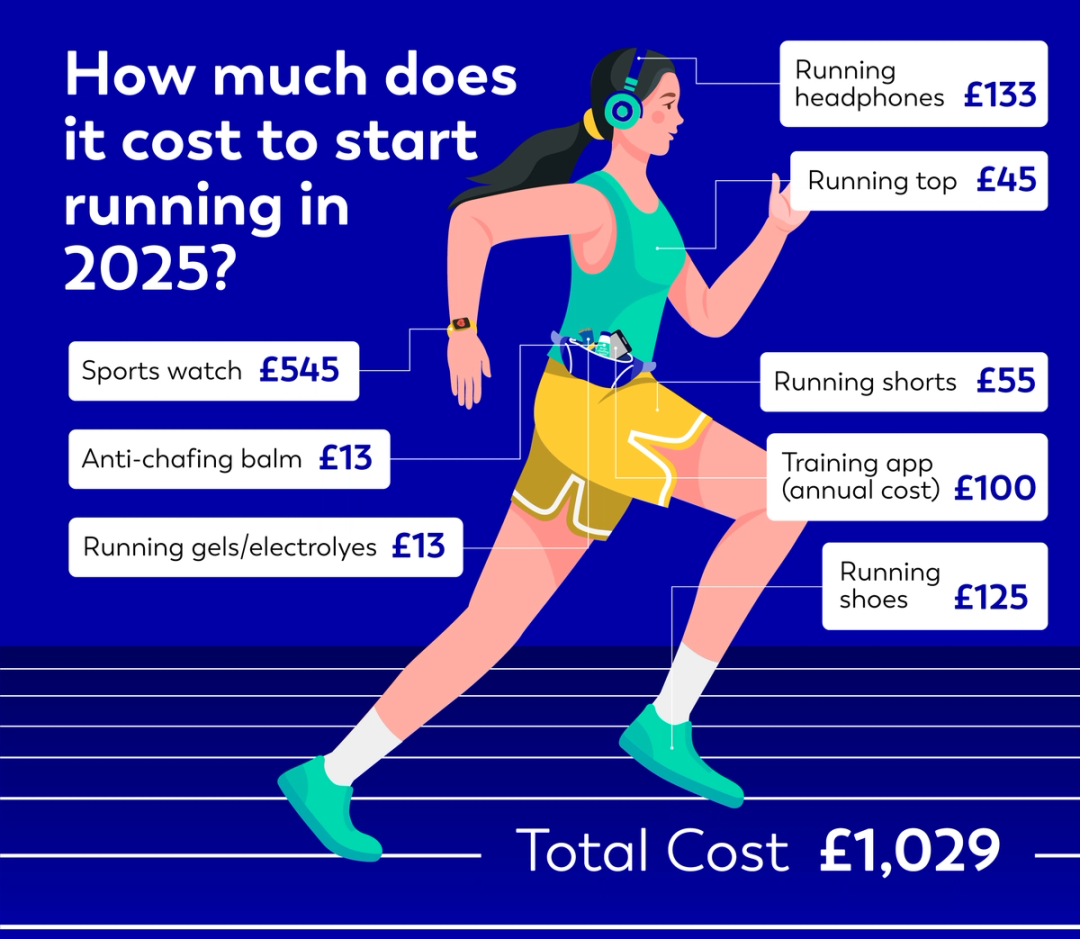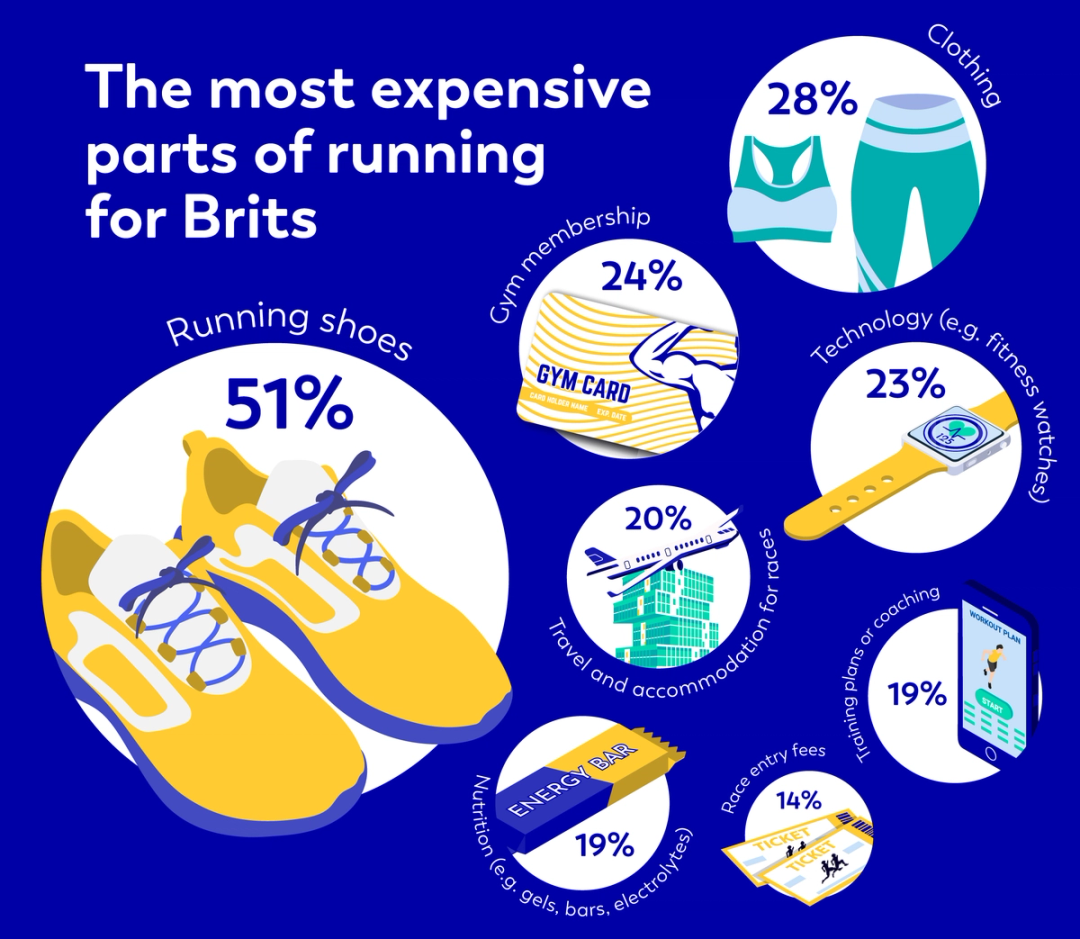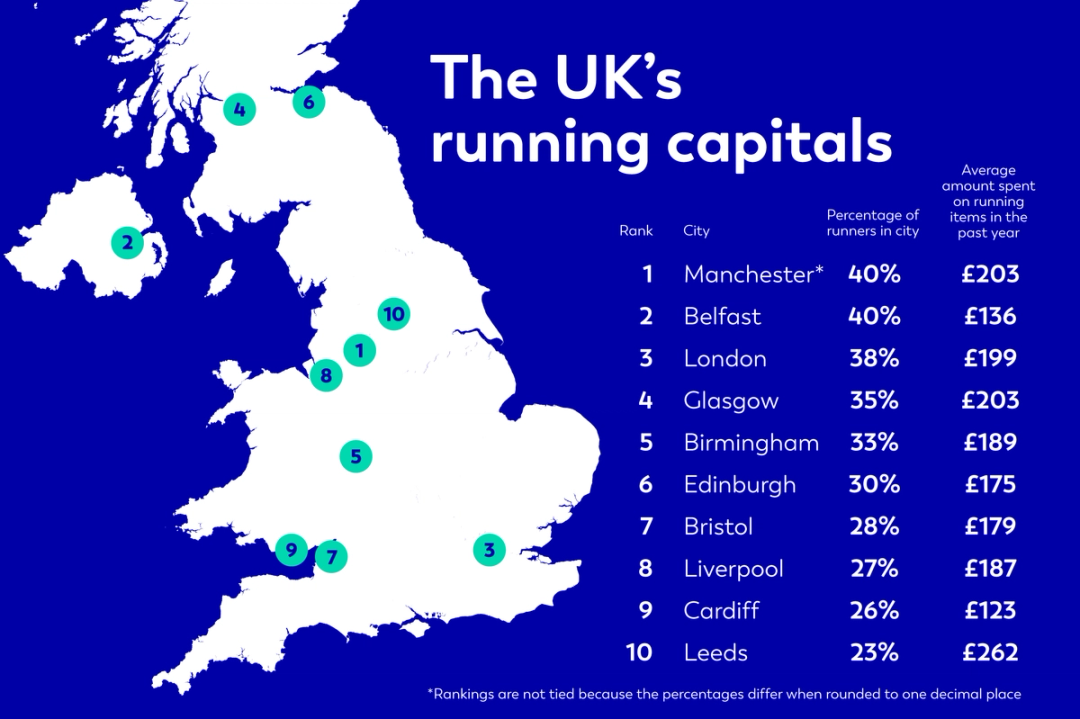The True Cost of Being a Runner
Aqua’s finance experts reveal how much UK runners really spend, uncovering hidden costs, city trends, and smart ways to save on your running journey

You may have noticed a recent surge in runners, whether it’s friends sharing their latest stats on social media, an uptick in #RunTok content in your feed, or simply more people hitting the pavement in your local area. If so, you’re not imagining it.
Our latest survey reveals that nearly 30% of Brits now identify as active runners. Supporting this trend, participation in organised running events has seen a notable 39% increase from 2023 to 2024. Much of this rise is being driven by the growing popularity of marathons and long-distance races, which are increasingly seen as bucket-list goals or personal milestones for many. But while the health and self-achievement benefits are clear, there’s another side to this growing movement that often goes unnoticed: the financial cost.
To get a clearer picture of the running boom, we surveyed 2,000 Brits to understand how many are lacing up regularly and how much they’re spending to fund their hobby. We also dug into the average cost of running essentials to uncover what it truly takes, financially, to stay on track.
What are the main costs associated with running?
While running doesn’t have to break the bank, and is often seen as an affordable fitness option, there can often be pressure, whether from peers, social media or personal goals to invest in the latest gear, gadgets and events. In fact, 24% of runners say they’ve been influenced by social media to purchase running-related products, highlighting just how powerful online trends can be in shaping spending habits.
Our survey revealed that 57% of runners feel pressure to spend money on their running gear, a feeling most common among those aged 16–24, with 74% in this group stating they feel that pressure. That’s why this guide explores innovative ways to cut costs, offering practical tips and budget-friendly hacks to help you enjoy the benefits of running without overspending.
The expenses involved in running can vary depending on one's habits, goals, and, of course, financial circumstances. In addition to our survey, we conducted desk research to reveal the average cost of running essentials in 2025.
How much it costs to start running in 2025
Our research has revealed that the average cost of starting to run in 2025 is £1,029. This figure includes a range of items that frequent runners may consider essential, such as running clothing, gels/electrolytes, running shoes, and headphones; however, not all of these may be necessary. What you choose to invest in depends on your budget and the type of training you’re doing.
The most expensive running essential is a sports watch, with the average cost totalling £545. Many runners use their sports watches to track their mileage, progress, and also to support recovery and wellness.
A good pair of running shoes is crucial for injury prevention and comfort, especially during longer or more intense runs. According to our research, a pair costs an average of £125. While quality running shoes can last a considerable amount of time, their lifespan largely depends on the number of miles you put on them.
Selecting the right shoe for your foot type and training style can make a significant difference to your performance and overall experience. That’s why getting a gait analysis before making a purchase is highly recommended; it helps ensure you're investing in the right fit for your needs.

In addition to having the right gear, running events are also surging in popularity. In fact, over 56,000 people finished the 2025 London Marathon (a world record), and ballot applications for the 2026 race reached over 1.1 million, breaking the world record set in last year's ballot of 840,318. This boom is driving more runners to factor in training, registration, travel, and accommodation costs into their running budgets. On average, a marathon entry in the UK costs £70, while a hotel stay in cities hosting these events costs around £77 per night.
How much are Brits spending on running?
The amount one person spends on their running gear can vary significantly from person to person. As part of our survey, we asked runners in the UK to estimate how much they have spent on running in the past year and what parts they found the most expensive.
Our findings reveal that within the last year, British runners have spent an average of £189 on running gear, with those aged 25-44 spending over £200 (£223) annually. When analysing the data at a city level, Norwich is spending the most on running gear, averaging £278, and Leeds follows with an average annual spend of £262.
Interestingly, men are spending 22% more a year on running gear than women, with men spending £203 a year and women £164.

Survey question asked Brits how much they spend on running gear, events, travel, nutrition, and personal trainers
What are the most expensive parts of running for Brits?
Running is often labelled as one of the most financially accessible sports, with all that’s needed being to lace up your trainers and get out the door. However, for some, what starts as a ‘free’ activity can quickly turn into a significant investment. So, which parts of the sport do runners find the most expensive?
1. Running shoes
Running shoes can be a significant investment, particularly when factoring in the need for different styles suited to your foot type, training routine, terrain, and personal goals. Many runners rotate between pairs for different purposes, like long runs, speed work, or trail running, which can cause the costs to add up quickly. For 51% of respondents, this is the most expensive part of running.
2. Clothing
The second most expensive part of running, according to 28% of Brits, is clothing. With the average pair of running shorts/trousers costing £55 and a top costing £45, it makes sense as to why clothing ranks so highly. Different weather conditions, varied training sessions, and ever-evolving trends often lead runners to regularly update their wardrobe. Those who cited this as one of the most expensive elements spent an average of £202 annually on running clothing.
3. Gym membership
Rounding out the top three expenses for UK runners is the cost of a gym membership, cited by 24% of respondents, spending an average of £221 a year on the membership, equating to just over £18 a month. While running can be as simple as heading out the front door, many people incorporate strength training or cross-training into their routines, which requires access to weights and additional equipment. During the winter months, shorter days and harsh weather may also lead some to opt for indoor treadmill runs, either for safety or comfort.

The UK’s running capitals
Our study also uncovered which UK cities are home to the most active runners, shedding light on where the running community is strongest.
Coming in first place is Manchester, where an impressive 40.5% of residents identify as active runners. Known for its vibrant sporting culture and access to scenic urban routes, Manchester leads the pack.
Close behind is Belfast, taking second place with 40% of people regularly lacing up their trainers, a reflection of the city’s growing fitness scene and dedication to wellness. London follows in third, with 38% of residents hitting the pavements, parks, and towpaths, proving that even in the hustle and bustle of city life, running remains a popular way to stay active.

Rankings are not tied because the percentages differ when rounded to one decimal place
Brits' top motivations for running
Across the UK, people take up running for a variety of reasons, each driven by their own motivations and goals – but what are the most popular ones?
1. Improve physical fitness
Improving fitness stands out as the leading motivation for runners in the UK, with 52% of Brits citing this as their primary reason for hitting the pavement. It’s no surprise, given that running is one of the most accessible forms of exercise, requiring little to no starting costs.
2. Mental health and stress relief
Mental health and stress release comes in second as the most common motivation for running, with 37% of Brits identifying this as their main reason to get moving. In a world where screen time averages over 5 hours, running offers a simple, yet powerful way for people to clear their minds. Whether it’s a quiet escape or an adrenaline boost, running can be great for providing much-needed headspace.
3. Weight loss/body transformation
Rounding out the top three is weight loss/body transformation, cited by 26% of runners in the UK. For many, running is an effective way to burn calories and work towards personal fitness goals. Running is also flexible; whether it is a brisk morning jog or a long weekend run, it can be easy to incorporate into daily routines and align with personal fitness levels.
Tips for running on a budget
The temptation to overspend on a running hobby can be high, especially with social media, tech advancements, and peer comparison in the mix. In fact, our survey revealed that 57% of runners feel pressure to spend money on new running gear. Luckily, there are smart ways you can keep costs down without compromising your performance, safety or enjoyment. Sharvan Selvam, Commercial Director at Aqua shares their tips for keeping the costs low when getting into running:
“Our research revealed that well over half of the country’s runners feel pressured to spend on running, from having the latest tech to a stylish kit. However, this is one of the most financially accessible ways to stay active, and it doesn’t have to come with a heavy price tag. There are several ways that you can still be a runner, without breaking the bank.”
1. Buy second-hand or discounted gear
You don’t need the latest kit to be a successful runner. Pre-loved running gear and shoes, especially those with minimal wear are widely available on platforms such as Depop, eBay and Vinted. Look for shoes from runners who tried a pair once or twice and found they weren’t the right fit; many are sold in a ‘like new’ condition for half the retail price.
2. Use free or low-cost training plans
You don’t need a pricey personal coach or premium app subscription to get structure in your training. Many effective running plans, such as Couch to 5K, or half-marathon training guides, are available online for free. For example, YouTube has coaching content from creators such as ‘The Running Channel’. Apps like Strava or Nike Run Club also offer free access to guided runs, community challenges and coaching tips.
3. Join a community
Running clubs are an affordable and effective way to connect with a community, stay motivated and learn from fellow runners. Whether you’re looking to meet new people, get advice, or simply find extra motivation to lace up your shoes, joining a club can make a big difference.
To find one near you, check out popular platforms like RunTogether, England Athletics or Meetup. You can also participate in parkrun, a free weekly 5K event held across the UK. It’s a great way to stay consistent with your training while becoming part of a welcoming, local running community.
4. Nutrition on a budget
Sports nutrition products such as energy gels, hydration tablets and recovery shakes can add up quickly. But many runners find success with lower-cost, everyday alternatives.
Energy gels: Use honey and packets of dried fruit like dates.
Electrolyte drinks: Add a pinch of salt and sugar to orange juice or water with lemon
Recovery shakes: Blend milk, bananas, oats and peanut butter for a home-made recovery shake.
Methodology & Sources:
To uncover the true cost of being a runner in 2025, we used a two-pronged research approach:
Quantitative Survey: We conducted a nationally representative survey of 2,000 respondents to explore runners' spending habits and psychological motivations. We asked participants about their purchases of running gear, tech, event fees, and other related costs, as well as their personal reasons for taking up and sticking with the activity.
Secondary (Desk) Research: We also carried out complementary desk research to determine the average prices for key running essentials in 2025, including footwear, apparel, nutrition, and fitness tech.
Failure to make payments on time or to stay within your credit limit means that you will pay additional charges and may make obtaining credit in the future more expensive and difficult.
Contributors

Hayley Bevan
Hayley is an editor at Aqua.

Victoria Smith
Victoria is an editor at Aqua.
You might also like
Slide 1 of 3
Summer Destinations: UK vs Europe
Discover where your money stretches further for summer holidays in 2025.
Hayley Bevan

The Great British Beer Garden
Experts at Aqua reveal the best UK cities for beer gardens, and how to successfully budget for summer.
Hayley Bevan

The best staycation destinations in the UK
New research by experts at credit card brand Aqua reveals which UK locations are the best, and most affordable, for...
Hayley Bevan
The smart way to build better credit
Aqua is the credit card that gives you the power to improve your credit score
